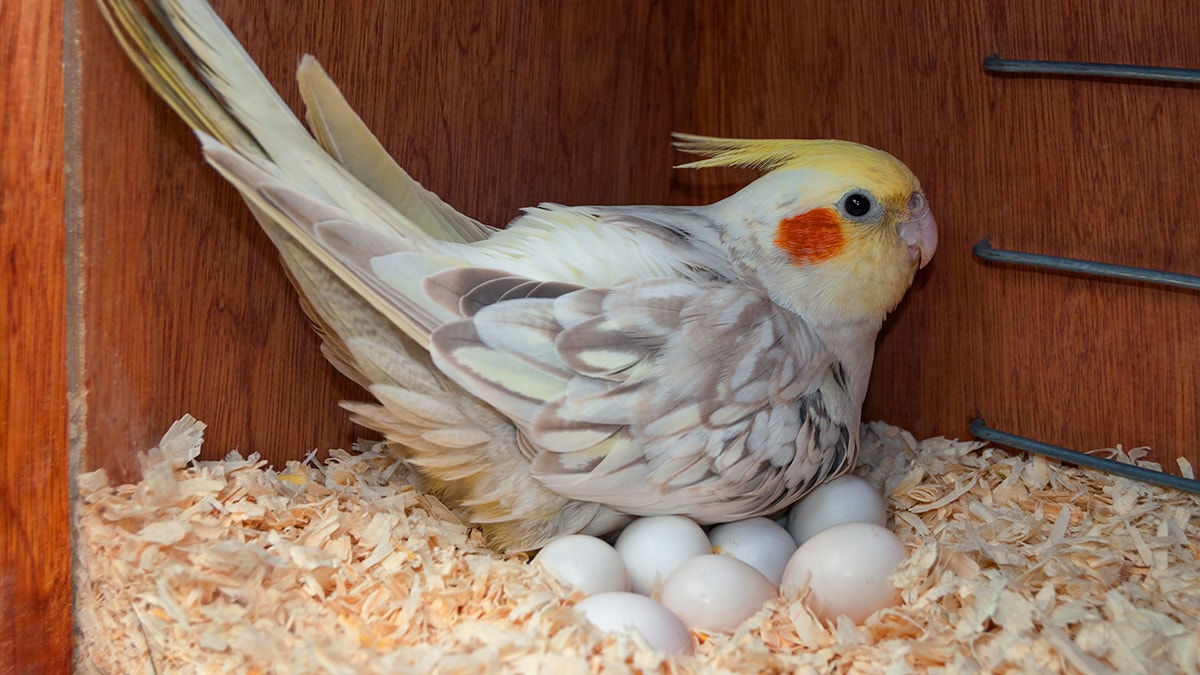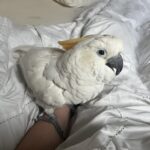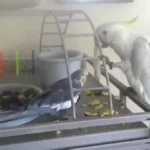A cockatoo typically lays 1 to 3 eggs per clutch. Egg laying frequency varies by species and breeding conditions.
Cockatoos, the crested parrots adored by many for their intelligence and affectionate nature, exhibit fascinating breeding behaviors. Within the bird-enthusiast community, understanding the reproductive habits of these avians is essential for both effective caretaking and species preservation. A critical piece of information for potential cockatoo owners and breeders is the number of eggs a female may lay.
This egg count forms the basis of chick expectations and influences how caretakers prepare for the successful rearing of young. Ensuring that cockatoos have the right environment and diet is pivotal for breeding success. Avian enthusiasts and breeders keep a close eye on these parameters alongside the cockatoo’s health to maximize the potential for a healthy clutch.

Credit: be.chewy.com
The Breeding Biology Of Cockatoos
The colorful world of cockatoos is mesmerizing. Their breeding biology is equally fascinating. Understanding how many eggs a cockatoo lays involves exploring different aspects of their life. From the influence of seasons to their unique mating rituals, each factor plays a crucial role in cockatoo reproduction.
The Role Of Seasons
Cockatoos are very sensitive to changes in seasons. Seasons signal the best time for them to start a family. The availability of food and the climate are critical. Most breeding occurs during spring or early summer when conditions are favorable. This timing ensures that the parent birds have plenty of food to feed their young.
- Spring: Optimal breeding season.
- Summer: Nesting and chick rearing continue.
- Fall: Preparing for non-breeding season.
- Winter: Rest period before next breeding cycle.
Mating Rituals
Cockatoos perform intricate mating rituals to attract their mates. These displays include vocalizations, feather displays, and dance moves. Males showcase their vigor and health through these performances. Once paired up, cockatoos are often monogamous. The pair bonds stay strong throughout the breeding season and can last for many years, even for life.
| Mating Stage | Activities |
|---|---|
| Attraction | Dances, calls, and feather displays |
| Courtship | Shared feeding and mutual preening |
| Nesting | Selection of nest site and preparation |
| Egg Laying | Typically 1-3 eggs per cycle |
Females lay between one to three eggs per breeding cycle. These eggs hatch after about 24 to 28 days of incubation. Both parents share the duties of incubation and feeding. Successful hatching leads to a bustling nest, where the cockatoo chicks grow until they’re ready to fledge.

Credit: featheredangels.wordpress.com
Nesting Habits Of Cockatoos
Are you curious about where cockatoos make their homes? Let’s dive into the intricate world of cockatoo nesting habits, exploring their choices and craftiness in nest building!
Location Preferences For Nests
Cockatoos are choosy about their homes. They look for spots that are safe and cozy. These birds typically favor tree cavities. But they’re also happy to nest in cliffs or rock faces if trees are scarce.
- Trees provide shelter from weather and predators.
- Cockatoos pick mature or even dead trees for their sturdiness.
- Height matters for safety. They often choose tall trees to stay out of reach.
- Proximity to food sources is key for these birds.
Materials And Construction
When it comes to building a home, cockatoos show real skills. They use available materials to craft the perfect nest. Each nest is unique and reflects the bird’s dedication.
| Material | Use |
|---|---|
| Wood Chips | For nest flooring |
| Leaves | To create a soft bed |
| Feathers | For insulation and comfort |
Cockatoos are hands-on builders. They use their strong beaks to shape the nest cavity. The interior is lined with soft materials for the eggs. Typically, a cockatoo’s nest resembles a simple yet sturdy sanctuary for its precious cargo.
Egg Laying Patterns
Understanding a cockatoo’s egg laying patterns is fascinating. When these birds reach maturity, their reproductive behavior kicks in. Let’s explore just how many eggs cockatoos lay and the details behind these patterns.
Frequency
Cockatoos lay eggs with a certain frequency. Typically, a cockatoo will lay one egg but may have up to four. Each egg arrives several days apart. They don’t lay eggs all year round. The laying season depends on factors like climate and species.
Timing In A Cockatoo’s Life Cycle
Timing is critical in a cockatoo’s life. They begin to lay eggs when they are fully mature, which is usually around 3 to 7 years old. This can vary between species. Cockatoos will lay eggs once or twice a year, adhering to their biological clock.
Understanding these patterns helps ensure that cockatoos live healthy, happy lives in captivity or the wild. Your knowledge of their reproductive habits reflects your care and commitment to these charismatic creatures.
Clutch Size Variation
When considering the breeding patterns of cockatoos, the number of eggs laid in a single clutch is a focal point. This clutch size can vary notably among different species and individual birds. It can tell us a lot about their reproductive strategies and the influences affecting them.
Average Number Of Eggs
Cockatoos generally lay between two to three eggs per clutch, with the entire laying process taking place over several days. Each egg then gets individual attention from the mother, who incubates them for about 20 to 30 days.
Factors Influencing Clutch Size
Several factors contribute to the variety in clutch size. Let’s examine these factors:
- Age of the Cockatoo: Younger and older females often lay fewer eggs.
- Nutrition: A diet rich in resources leads to larger clutch sizes.
- Environment: Stable, secure environments can encourage larger clutches.
- Health: The overall health of the bird can affect egg production.
- Season: Breeding seasons may impact the number of eggs laid.
Incubation Period
The incubation period is a remarkable stage in the breeding cycle of cockatoos. It starts when the last egg is laid. During this crucial time, the developing embryos inside the eggs require constant attention and the right conditions to develop successfully into healthy chicks.
Duration
The incubation period for cockatoos typically spans between 20 to 29 days. This period may vary slightly among different species of cockatoos. To ensure a stable environment, the temperature and humidity inside the nest are critical. The eggs should be kept around 35°C (95°F) with a proper humidity level to facilitate proper embryo development.
Parental Roles During Incubation
During the incubation period, both male and female cockatoos play crucial roles. The female usually spends more time on the eggs, while the male takes on the duty of feeding and protecting.
- The female spends most of her time warming the eggs.
- She turns them periodically to ensure even heat distribution.
- The male frequently provides food for the brooding female.
- He also stands guard against potential predators.
Hatching Process
The journey from an egg to a fully-fledged cockatoo is fascinating. Let’s delve into the hatching process of a cockatoo’s egg. Each phase is critical and laden with anticipation. Understanding this cycle sheds light on the amazing start of a cockatoo’s life.
Hatching Success Rate
Nesting cockatoos generally lay between one and three eggs. Not every egg guarantees a chick. The success rate for hatching can vary greatly. Factors like environment, health, and age play significant roles. On average, 60 to 70 percent of the eggs will successfully hatch into chicks.
Chick Development Milestones
After the thrilling moment of hatching, chicks hit several key growth markers. Below are the milestones they speed through:
- Day 1: Chicks emerge blind and featherless.
- Week 1: Patches of down appear.
- Week 2-3: Eyes start to open; soft feathers form.
- Month 1: Steady growth; more feathers emerge.
- Month 1.5: Begin to look like mini cockatoos.
- Month 2-3: Start to climb and explore nest.
By end of the third month, fledgling begins. Cockatoo chicks prepare to leave the nest and fly on their own. The hatching and growth of each cockatoo chick is a unique and magical process to behold.
Challenges To Egg Laying
Conservation Status
The Conservation Status of cockatoos is a crucial topic for ornithologists and bird lovers. These vibrant birds, often known for their intelligence and charm, face various threats in the wild. Understanding their breeding patterns, such as how many eggs they lay, provides insight into their survival prospects.
Impact Of Clutch Size On Population
Cockatoos typically lay one to three eggs per clutch, although the number can vary. Even with these few eggs, not all hatchlings survive to adulthood. The number of eggs laid directly influences the ability of the cockatoo population to replenish itself. Predation, habitat loss, and climate change further complicate their reproductive success.
- Large clutches may not always mean higher survival rates.
- Incubation and fledgling care deeply affect chick survival.
- Consistent clutch sizes ensure a stable growth rate for cockatoo populations.
Conservation Efforts
Protecting cockatoos involves global cooperation and targeted strategies. Efforts to support their conservation include habitat preservation, breeding programs, and public education.
- Legislation to protect vital breeding grounds.
- Programs assisting with safe nesting sites.
- Rehabilitation for injured or displaced birds.
| Cockatoo Species | Conservation Status | Average Clutch Size |
|---|---|---|
| Yellow-Crested Cockatoo | Critically Endangered | 2-3 eggs |
| Blue-Eyed Cockatoo | Vulnerable | 2 eggs |
Conservation groups work tirelessly to halt the decline of cockatoo species. They track breeding patterns, like egg-laying frequency, to prioritize conservation actions. Engaging local communities ensures that these majestic birds thrive for generations to enjoy.

Credit: www.amazon.com
Conclusion
Understanding cockatoo breeding habits enlightens bird enthusiasts about their egg-laying patterns. Generally, cockatoos lay between 1 to 3 eggs per clutch. Caring for these birds requires knowledge of their reproductive cycles, ensuring their health and well-being is maintained. Grasping these details aids in responsible cockatoo caretaking and can enrich the breeding experience for all involved.
Ryan Everhart is a passionate bird enthusiast and blogger, primarily writing on his website, Avian Whispers. His journey into the world of bird blogging began with a deep interest in parrots, a species that captivated his attention for their intelligence and social behavior. Over time, his content expanded to cover a broader range of bird species, offering insights into bird behavior, care, habitats, and conservation.
Ryan is dedicated to educating his audience, which includes both new bird owners and seasoned enthusiasts. His writing is filled with personal experiences, expert knowledge, and practical advice on bird care. Through Avian Whispers, he aims to foster a deeper appreciation for birds, emphasizing their role in nature and the joys of having them as pets.
Starting with articles focused on parrots, Ryan’s work now encompasses a diverse range of topics such as feeding, training, habitat enrichment, and bird health. His love for birds extends beyond parrots, diving into various avian species. His informative and heartfelt writing reflects his commitment to the well-being of birds and the desire to help others connect with these creatures.
As a growing voice in the bird blogging community, Ryan strives to provide a platform where bird lovers can learn, share experiences, and connect over a shared passion for avian life. His blogs are not only educational but also serve as a reminder of the importance of protecting and nurturing the bond between humans and birds.




